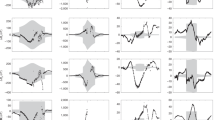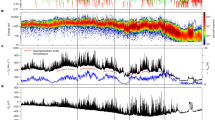Abstract
The solar wind is an extended ionized gas of very high electrical conductivity, and therefore drags some magnetic flux out of the Sun to fill the heliosphere with a weak interplanetary magnetic field1,2. Magnetic reconnection—the merging of oppositely directed magnetic fields—between the interplanetary field and the Earth's magnetic field allows energy from the solar wind to enter the near-Earth environment. The Sun's properties, such as its luminosity, are related to its magnetic field, although the connections are still not well understood3,4. Moreover, changes in the heliospheric magnetic field have been linked with changes in total cloud cover over the Earth, which may influence global climate5. Here we show that measurements of the near-Earth interplanetary magnetic field reveal that the total magnetic flux leaving the Sun has risen by a factor of 1.4 since 1964: surrogate measurements of the interplanetary magnetic field indicate that the increase since 1901 has been by a factor of 2.3. This increase may be related to chaotic changes in the dynamo that generates the solar magnetic field. We do not yet know quantitatively how such changes will influence the global environment.
This is a preview of subscription content, access via your institution
Access options
Subscribe to this journal
Receive 51 print issues and online access
$199.00 per year
only $3.90 per issue
Buy this article
- Purchase on Springer Link
- Instant access to full article PDF
Prices may be subject to local taxes which are calculated during checkout
 where c is the correlation coefficient between two consecutive 27-day intervals of 12-hourly aa values13,23.
where c is the correlation coefficient between two consecutive 27-day intervals of 12-hourly aa values13,23.



Similar content being viewed by others
References
Gazis, P. R. Solar cycle variation of the heliosphere. Rev. Geophys. 34, 379–402 (1996).
Balogh, A.et al. The heliospheric field over the south polar region of the sun. Science 268, 1007–1010 (1995).
Willson, R. C. Total solar irradiance trend during cycles 21 and 22. Science 277, 1963–1965 (1997).
Lean, J., Beer, J. & Bradley, R. Reconstruction of solar irradiance since 1610: implications for climate change. Geophys. Res. Lett. 22, 3195–3198 (1995).
Svensmark, H. & Friis-Christensen, E. Variation of cosmic ray flux and global cloud coverage—a missing link in solar-climate relationships. J. Atmos. Sol. Terr. Phys. 59, 1225–1232 (1997).
Mayaud, P. N. The aa indices: a 100-year series characterising the magnetic activity. J. Geophys. Res. 72, 6870–6874 (1972).
Stamper, R., Lockwood, M., Wild, M. N. & Clark, T. D. G. Solar causes of the long-term increase in geomagnetic activity. J. Geophys. Res.(in press).
Russell, C. T. On the possibility of deducing interplanetary and solar parameters from geomagnetic records. Sol. Phys. 42, 259–269 (1975).
Gringauz, K. I. in Solar Wind 4(ed. Rosenbauer, H.) (Rep. MPAE-W-100-81-31, MPI für Aeronomie, Lindau, Germany, (1981).
Feynman, J. & Crooker, N. U. The solar wind at the turn of the century. Nature 275, 626–627 (1978).
Baker, D. in Solar Wind-Magnetosphere Coupling(eds Kamide, Y. & Slavin, J. A.) 17–38 (Terra Scientific, Tokyo, (1986).
Wang, Y.-M. & Sheeley, N. R. J Solar implications of Ulysses interplanetary field measurements. Astrophys. J. 447, L143–L146 (1995).
Cliver, E. W., Boriakoff, V. & Bounar, K. H. The 22-year cycle of geomagnetic activity. J. Geophys. Res. 101, 27091–27109 (1996).
Silverman, S. W. Secular variation of the aurora for the past 500 years. Rev. Geophys. 30, 333–351 (1992).
Sonnet, C. P. Long-period solar terrestrial variability. Rev. Geophys. (Suppl.: US Nat. Rep. to IUGG 1987–1990 909–914 (1991).
Beer, J., Tobias, S. & Weiss, N. An active sun throughout the Maunder minimum. Sol. Phys. 181, 237–249 (1998).
Feynman, J. & Gabriel, S. B. Period and phase of the 88-year solar cycle and the Maunder minimum: evidence for the chaotic sun. Sol. Phys. 127, 393–403 (1990).
Cliver, E. W., Boriakoff, V. & Feynman, J. Solar variability and climate change: geomagnetic aa index and global surface temperature. Geophys. Res. Lett. 25, 1035–1038 (1998).
Vasyliunas, V. M., Kan, J. R., Siscoe, G. L. & Akasofu, S.-I. Scaling relations governing magnetospheric energy transfer. Planet Space Sci. 30, 359–365 (1982).
Scurry, L. & Russell, C. T. Proxy studies of energy transfer to the magnetosphere. J. Geophys. Res. 96, 9541–9548 (1991).
Merrill, R. T., McElhinny, M. W. & McFadden, P. L. The Magnetic Field of the Earth 34 (Academic, San Diego, (1996).
Wang, Y.-M., Hawley, S. H. & Sheeley, N. R. J The magnetic nature of coronal holes. Science 271, 464–469 (1996).
Sargent, H. H. in Solar Wind-Magnetosphere Coupling(eds Kamide, Y. & Slavin, J. A.) 143–148 (Terra Scientific, Tokyo, (1986).
Hapgood, M. A. Adouble solar-cycle variation in the 27-day recurrence of geomagnetic activity. Ann Geophys. 11, 248–253 (1993).
Webb, D. F. & Howard, R. A. The solar cycle variation of coronal mass ejections and solar wind mass flux. J. Geophys. Res. 99, 4201–4220 (1994).
Acknowledgements
The data used are stored and made available via World Data Centre C1 for STP at RAL, which is funded by the UK Particle Physics and Astronomy Research Council and, until 1 April 1999, by the National Radio Propagation Programme of the Radiocommunications Agency. We also thank the many scientists who have contributed data to the WDC.
Author information
Authors and Affiliations
Corresponding author
Rights and permissions
About this article
Cite this article
Lockwood, M., Stamper, R. & Wild, M. A doubling of the Sun's coronal magnetic field during the past 100 years. Nature 399, 437–439 (1999). https://doi.org/10.1038/20867
Received:
Accepted:
Issue Date:
DOI: https://doi.org/10.1038/20867
This article is cited by
-
Reconstructing Sunspot Number by Forward-Modelling Open Solar Flux
Solar Physics (2024)
-
Reconstruction of Carrington Rotation Means of Open Solar Flux over the Past 154 Years
Solar Physics (2024)
-
Long-Term Modulation of Solar Cycles
Space Science Reviews (2023)
-
A history of solar activity over millennia
Living Reviews in Solar Physics (2023)
-
Revising a less-reliable prediction for the solar cycle based on the variation in correlation
Indian Journal of Physics (2023)
Comments
By submitting a comment you agree to abide by our Terms and Community Guidelines. If you find something abusive or that does not comply with our terms or guidelines please flag it as inappropriate.



